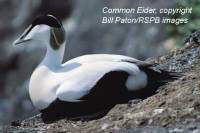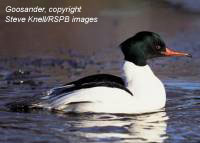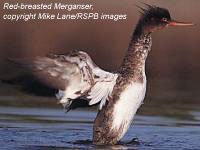
BALTIC OIL SPILL THREATENS BIRDS & IMPORTANT FEEDING GROUNDS
Cambridge, UK, 30 March 2001. Thousands of water birds and two near feeding grounds classed as Important Bird Areas (IBAs) are threatened by the leakage of heating oil from the tanker, Baltic Carrier, following a collision with a freighter on Wednesday several miles south-east of Falster and Moen islands off south-east Denmark, according to BirdLife International, worlds leading authority on the status of birds [1,2].
 The bird species at risk are Eider ducks, (Somateria spp), Long-tailed Duck (Clangula hyemalis), Red-breasted Merganser (Mergus serrato), Goosander (Mergus merganser) and Swans (Cygnus ssp). The two IBAs under immediate threat due to the present wind direction are Ulvsund and Grunsund IBA (8,160ha), which is also a Special Protection Area (SPA), protected under EU nature conservation legislation, and Westrugen-Hiddensee-Zingst (26,250ha), an IBA and National Park in the Mecklenburg-Vorpommern region of Germany.
The bird species at risk are Eider ducks, (Somateria spp), Long-tailed Duck (Clangula hyemalis), Red-breasted Merganser (Mergus serrato), Goosander (Mergus merganser) and Swans (Cygnus ssp). The two IBAs under immediate threat due to the present wind direction are Ulvsund and Grunsund IBA (8,160ha), which is also a Special Protection Area (SPA), protected under EU nature conservation legislation, and Westrugen-Hiddensee-Zingst (26,250ha), an IBA and National Park in the Mecklenburg-Vorpommern region of Germany.
"BirdLife International has identified 26 Important Bird Areas in the Baltic Sea plus 19 along the Baltic coast of Denmark and Germany. Almost all of these are protected as Special Protection Areas under the EU Birds Directive. These figures clearly underline the importance of improving precautionary measures such as the use of licensed pilots in the area", said Szabolcs Nagy BirdLife International's European Conservation Manager.
Germany. Almost all of these are protected as Special Protection Areas under the EU Birds Directive. These figures clearly underline the importance of improving precautionary measures such as the use of licensed pilots in the area", said Szabolcs Nagy BirdLife International's European Conservation Manager.
These sites are classed as IBAs because they are nationally and internationally important sites for the conservation of migratory birds and were selected according to internationally recognised criteria.
"These shallow Danish waters are extremely important for wintering and migratory water birds, but are also extremely risky for navigation. At present, over 10,000 birds are in the vicinity of the spill", said Knud Flensted, Conservation Officer of DOF (BirdLife in Denmark).
"The authorities are making all the efforts possible to avert a dis aster, however, we need to learn from this accident and make the use of licensed pilots obligatory in order to aid safe passage in these risky waters. As maritime transports increase, oil spills pose a growing threat to marine ecosystems around Denmark".
aster, however, we need to learn from this accident and make the use of licensed pilots obligatory in order to aid safe passage in these risky waters. As maritime transports increase, oil spills pose a growing threat to marine ecosystems around Denmark".
Approximately 2,000 tons of heavy heating oil have leaked from the Baltic Carrier after a collision with the freighter, Tern, which ripped a 20metre hole in the hull [3,4]. Bulk heating oil contains flame retardant chemicals. Some of these chemicals can increase the toxicity of the oil. For further information contact Adrian Long in Cambridge on + 44 1223 277 318 or 07779 018322 (m) or Sara Sharpe in Wageningen, Netherlands, on + 31 317 478836 or + 31 617 312068 (m).
NOTES:
1. BirdLife International is a global alliance of conservation organisations working in more than 100 countries who, together, are the leading authority on the status of birds, their habitats and the issues and problems affecting bird life. BirdLife International also has a global Seabirds Programme which aims to conserve the worlds threatened seabirds.
2. The Important Bird Areas (IBA) Programme of BirdLife International is a worldwide initiative aimed at identifying and protecting a network of sites critical for the conservation of the worlds birds. The European IBA Programme is the longest running of a number of regional IBA programmes and for the last decade has addressed site-orientated research and action, encompassing habitat management, monitoring, education, advocacy and national and international legal protection.
3. Previous major oil spills affecting seabirds include the Treasure which sank off the west coast of South Africa in 1994. Fuel oil leaking from the ship surrounded the nearby Robben and Dassen Islands, both of which host important colonies of African Penguins Spheniscus demersus. Up to 40% of the world population of this globally threatened species was in danger, but thanks to the timely efforts of 40,000 rescuers and BirdLife Partners (BirdLife South Africa, LPO, RSPB and WBFT) 23,000 oiled birds were able to=20 be taken to be cleaned at Southern African Foundation for the Conservation of Coastal Birds (SANCCOB) centres and 20,000 unoiled birds temporarily removed to Port Elizabeth to avoid oiling. The sinking of the Erika off the Brittany coast in late December 1999 is another dramatic example of the effect oil pollution can have on seabirds. By the end of January 2000, a total of almost 61,000 oiled birds had been handled, of which nearly 52,000 were dead and nearly 9,000 oiled but still alive (although their survival chances are low, especially if they were heavily oiled and ingested oil). This means that the known number of dead birds already far exceeded the estimated total of birds killed in the UK by the Torrey Canyon disaster in 1967, the previous worst incident on the Atlantic coast. The estimated total number of dead seabirds, making allowances for the fact that a far greater proportion of birds die at sea and are never recovered than are actually brought ashore, puts the number of dead birds at 100,000 to 150,000. However, other estimates put the total at a far higher level - perhaps as high as 200,000 or 300,000 birds in this disaster.
4. Oil can affect seabirds directly through coating the plumage of birds and reducing water-proofing properties of the feathers. As birds preen the oiled plumage, toxic residues can be ingested and adversely affect their metabolism leading to dehydration and poisoning.
